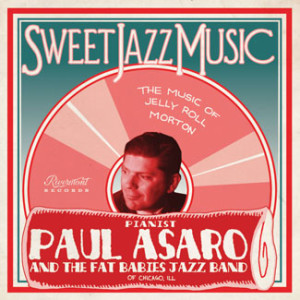Paul Asaro’s ebullient stride-piano technique vividly
evokes an earlier era. You don’t encounter pre-bebop jazz
of this quality and commitment very often anymore.”
– Howard Reich of Chicago Tribune
FAQ
Frequently Asked Questions
Does Paul perform solo or with a group?
Both. Paul performs solo piano in clubs, concerts, and music festivals worldwide. He also currently tours as a duo with Leon Redbone and plays regularly with the Fat Babies, a Chicago-based traditional jazz group specializing in the music from the 1920s and 1930s. Its hard-driving swing has made it a popular favorite for both dancers and listeners alike.
What is a Paul Asaro solo piano performance like?
All of Paul’s solo performances involve a variety of piano styles from Ragtime to Stride, Jelly Roll Morton, and Boogie Woogie as well as vocals. Four solo piano performance situations are the most common: Club dates consisting generally of one or more 45 minute sets; Private parties or events held at homes, restaurants, banquet halls. or hotel conference rooms, and Music Festival appearances. Paul’s one man theatrical show “From Ragtime To Jazz” tells the story of how ragtime developed into stride piano and the New Orleans piano jazz stylings of Jelly Roll Morton. The show runs two hours with one intermission but can be accommodated to fit almost any time frame. This show has toured successfully playing for a variety of arts organizations, schools, and community concert associations.
What do I need to supply for a Paul Asaro one man show?
Almost any performance setting with a piano and basic sound and lighting is adequate for this show including theaters and school auditoriums as well as restaurants and clubs.
How can I contact Paul with questions about booking?
Fill out Paul’s booking form with the details of your venue and booking inquiry, and he will contact you shortly!
What is Stride Piano and what is the difference between Ragtime and Stride?
Ragtime is an original American musical genre which enjoyed its peak popularity between 1897 and 1917. Its main defining characteristic trait is its use of sycopated rhythms in the melody juxtaposed over a steady march-like bass. Ragtime was played by all varieties of instrumentalists, bands, and orchestras but is most well known today as a solo piano style. On the piano the characteristic syncopated melodies are played by the right hand while the march-like bass is played by the left. In general it is recognized as a fusion of European style marches, especially those in America made popular by John Philip Sousa, with polyrhythms coming from African music by way of drums, banjo, and eventually the piano. Scott Joplin became ragtime’s most famous composer in 1899 with the publication of “Maple Leaf Rag”, setting the standard for piano ragtime composition and style, especially in the Midwest, for many years to come.
Harlem Stride Piano developed out of the ragtime piano styles of New York City and the east coast, also known as “Eastern Ragtime”. The style continued the ragtime tradition of a march-like left hand see-sawing between a single bass note at the bottom of the keyboard, and a chord struck in the center of the keyboard. In general, ragtime pianists only stretched an octave or an octave and a half between the bass note and the chord in the middle but the stride pianists stretched much further towards the bottom end of the keyboard and the wider span give a much fuller sound. The syncopated figures in the right hand evolved into more varied and complicated patterns involving all manner of thirds, sixths, tenths, chromatic runs, broken chords, glissandos, and tremolo octaves. As it developed during the declining years of ragtime’s popularity and during the rise of the jazz age it further distinguished itself from ragtime piano in its sense of “swing” in the rhythm and its increasing use and the complexity of improvisation during perfomance. Stride piano was an east coast development and differed stylistically from the New Orleans jazz pianists such as Jelly Roll Morton in its voicings and melodic figures.
Learn more about stride piano on the stride piano history page!


